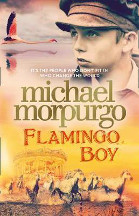Flamingo boy by Michael Morpurgo

HarperCollins, 2018. ISBN 9780008134648
(Age: 8+) Highly recommended. Themes: World War Two, Gypsies, Nazis,
Bullying, Flamingoes, Animals, Trust, Vincent van Gogh. At the end
of his final year at school, Vincent dons a backpack and walks
though the Camargue in Southern France, once the home of Vincent the
name on the painting which has always been in his bedroom. Suddenly
ill, he is befriended by a woman and man who share a house: Lorenzo
is a seemingly simple man, devoted to his animals, and the woman,
Zia, once a gypsy, cares for him as a lifelong friend would.
One night Zia begins her story, allowing Vincent to see what lies
beneath their friendship, how they came to share a house, and the
tale of how they survived the war.
Morpurgo layers story upon story in this mesmerising account, as he
rounds out each of the main characters, filling in their backgrounds
as we read. Each story is intimate and revealing, reflecting the way
we should all behave in the face of tyranny and injustice.
Zia's family owns a carousel which they play each year in the local
town. Lorenzo loves to ride the horse on the carousel and the two
families grow closer. Zia hates school where she is bullied for
being a gypeo, and Lorenzo's mother offers to teach her at the farm.
When the Nazis take over the area, the gypsy family moves to the
farm, a place of safety away from prying eyes, as gypsies are one of
the groups sent to prison camps.
Here Lorenzo shows Zia his hospital shed where he cares for injured
animals, especially the flamingo a familiar sight in the Camargue as
they nest there every year. But people stealing the flamingo eggs
are stopped by Lorenzo and his father, and in retaliation tell the
authorities where the gypsy family is hiding.
This is yet another masterful story from Morpurgo, giving the
readers a revealing tale of World War Two, making it more intimate
by placing it within a small community, wrapping it with
environmental concerns, reflecting the schemes of the Nazi invaders,
but tempering it with sympathy shown by the man in charge.
Readers will recognise the bullying which occurs on many levels: the
children as they taunt the 'flamingo boy', and Zia, the gypsy girl,
the Jewish teacher removed from the school, the townspeople
informing on the family hiding at the farm and the Nazi thugs who
take the family from the farm, showing readers how easy it is to
denigrate others.
Zia and Lorenzo are still friends and Morpurgo ties the story
together with Vincent van Gogh, the name he started with, who killed
himself because he was so alone. Morpurgo makes his point with
composure in this highly readable book.
This novel is most suitable for middle school readers, and teachers
wanting a novel to initiate discussion around the idea of bullying
in all of its forms, from Nazism to that found in the community and
classroom.
Fran Knight